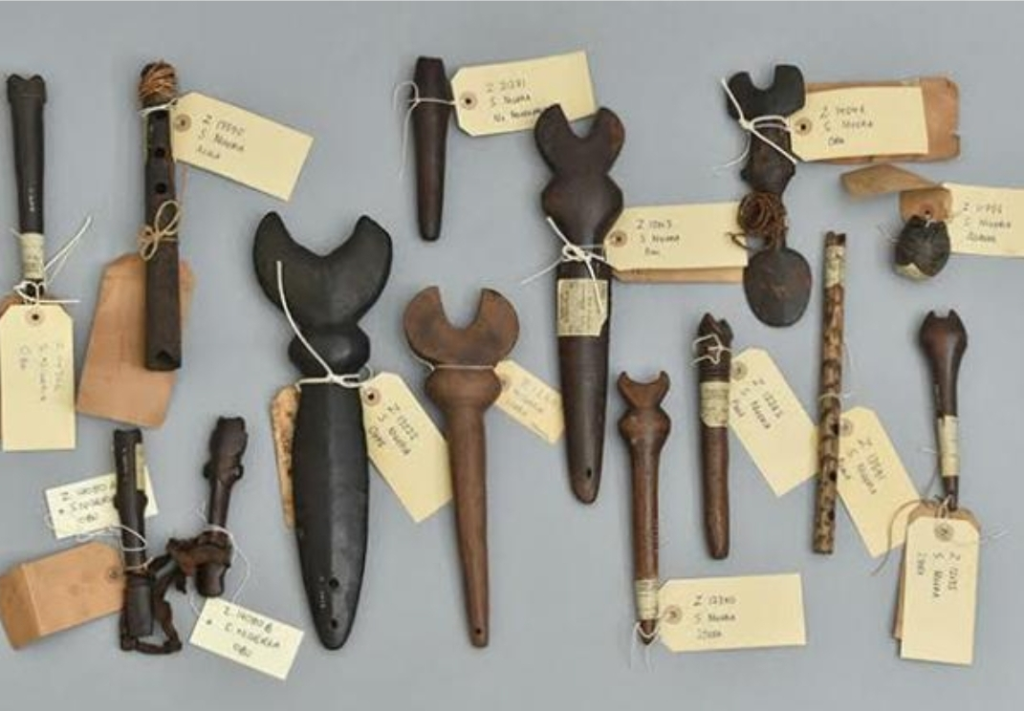
The Ọjà is a highly regarded flute of a great tradition among the Igbo-speaking people of Nigeria. Centuries back, it was a device that evoked so much more than music. This highly acclaimed Ọjà can be used for communication, storytelling, and ritual. Its versatility and portability gave it enduring longevity for so many centuries, which easily engraved the device in Igbo tradition.
Anthropological Observations
Anthropological Observations carried out an intensive series of surveys in Southern Nigeria between 1909 and 1913, following which focused attention on the Edo and Igbo-speaking regions. These included studies of local forms of flutes among which was the finding that “The flute, together with the drum, is the instrument most frequently used.”. In his Anthropological Report on the Ibo-speaking Peoples of Nigeria, they took note that two or three kinds of flutes were fashioned out of wood, whereas another type was ‘made from a calabash, with cow skin drawn over it’.
Thomas also documented that the Edo word for those flutes were alele, elele or ulele, while the Igbo name for theirs was called an Ọjà. He further gave various contexts in which the ọja was employed, including wrestling matches, making walls, and drinking palm wine. While his recordings using the wax cylinder phonograph garnered many forms of flute music, he gave few details. Nevertheless, his work represented the importance of the ọja in the cultural life of Southern Nigeria.
Structure and Varieties of the Ọja
The Ọjà is a wind instrument that is either wooden or of bamboo material.
There are two types: the ọja wooden, which is end-blown, and the bamboo ọja side-blown. Over time, the only one that survived was the wooden ọja, probably because of the importance this instrument has in Igbo cultural life. What characterizes the ọja is its shrill sound, which differentiates one flute from another by its size. The smallest ọja is approximately 14 cm, and the largest is approximately 26 cm in length.
These ọja have various functions according to their types in Igbo society:
Ọjà -mmonwu: Smallest and highest-pitched, used in masquerade music.
Ọjà -okolobia: Used in ceremonies marking the coming of age of young men.
Ọjà -igede: The low-pitched ọja plays in pairs during a burial rite, with one ọja leading and responding to the other ọja.
Ọjà -ukwe: A medium-pitched ọja used to accompany women’s dances.
The difference in pitch and function of the oja throws into focus its application both in musical and non-musical domains. As an instrument of non-verbal communication, it serves to give cues, signals, or encouragement to dancers and performers. Ọjà can even serve as a master conductor, guiding entire performers, especially during masquerades.

Cultural Significance and Spirituality
The Ọjà holds a unique place in Igbo folklore and spirituality. Because of its properties in communicating with the human and spirit worlds, it has been popularly referred to as the talking flute. According to Igbo beliefs, this musical sound from the ọja is capable of quieting raging spirits, strengthening the weak, and giving points of praise and salutations at important ceremonies. This would be the case when there are reports that the ọja has chosen its master, to which a mystical relationship would exist between the player and his instrument. In the Igbo fable of Ọjà Adili-a story about one great wrestler who entered the spirit world Ọjà fascinating and sometimes dangerous influence is overemphasized.
The story is a good example of how the music of the ọja led Ọjà Adili to the defeat of powerful spirits but to meet his demise at the hands of his chi. It illustrates the double-edgedness of the ọja: it inspires great feats yet causes one’s downfall. As in “Ọjà adufuo dike” meaning the ọja leads a strong man astray. The Ọjà in Contemporary Igbo Music
As of today, the Ọjà continues to maintain relevance in modern Igbo culture. A lot of them are always used in modern music along with other traditional instruments, which include ekwe, that is, wooden slit drum; udu, a clay pot drum; ogene, a metal gong; and igba, that is, drum. Even in these modern times, Igbo musicians, such as Flavour and Phyno, well protectively grace the music stage with ọja sounds while retaining the goals of their legacy among new audiences.
Its melodious and sonorous sound, especially in the Ọjà-ukwe used in women’s dance, remains captivating to audiences. The flute, because of its high pitch, produces this weird liveliness in performance that keeps it ahead as the life of Igbo music. In fact, hypnotic, the flute sound was said to make people part with their money on the spot, as was reportedly the case with Unoka, Okonkwo’s father in Chinua Achebe’s Things Fall Apart.
Decline of Ọjà Players
Regrettably, over time, fewer good ọja players were available, and fewer modern people bothered to learn the instrument. In fact, most of those who play the ọja nowadays do it as a means of begging for money instead of learning the depth of its art and cultural sense. This quite new trend therefore poses a threat to the spiritual and traditional aspect of the ọja.
With the ọja, one must listen to fully appreciate it, but more so, one has to understand its history, its function, and spiritual depth. It is alive and an instrument that talks of the past yet is very pertinent in Igbo identity.
The Ọjà flute is enveloped in a rich historical and traditional background, which still portrays the Igbo people’s existence in culture. It is much more than an instrument; it communicates, ritualizes, and serves as an artistic expression—a link between the material and spiritual worlds of the Igbo people.
Reference:
- Lo-Bamijoko, J. N. (1987) ‘Classification of Igbo Musical Instruments’, African Music 6(4): 19-41.
- Anthropological Observations (1913) on the Ibo-speaking Peoples of Nigeria, Part 1: Law and Custom of the Ibo of the Awka Neighbourhood, London: Harrison & Sons.




